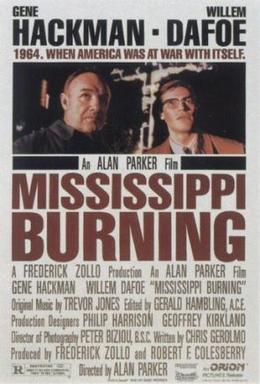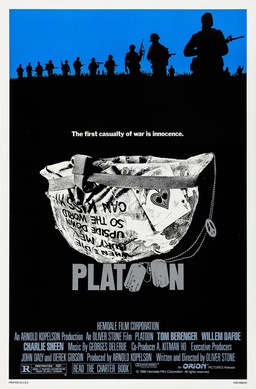
WILLEM DAFOE

SCREEN CHARACTER BIG AND SMALL TRANSGRESSES MORAL DIVIDE
By PETER THOMAS BUSCH
The biopic character had incredulously been involved in a federal security detail for black students attending an all white school in the racially segregated South.
Even more incredulous perhaps was watching the rising star of a young new character actor who was so new and so talented that the disbelief of everyone around him on the set was continually suspended.
In Mississippi Burning (1988) director Alan Parker casts Gene Hackman as FBI Agent Rupert Anderson, with Willem Dafoe costarring as Agent Alan Ward, in the story about the FBI investigation into missing civil rights activists who had been organizing voter rights clinics for African Americans.
Mr. Ward had been assigned to black civil rights activist James Meredith at Ole Miss that first day of admission to the segregated university in 1962. And now, Mr. Ward was in charge of an investigation that would find clues about the missing voter rights activists at the sheriff department in Jessup County and at the Ku Klux Klan rallies.
Dafoe creates the performance by tapping into the righteousness held by those people given the moral authority to intervene. Hackman is the more experienced actor and plays that part as a senior agent who must begrudgingly allow a younger, less experienced agent stumble about the segregated sets of the deep South.
Dafoe must simultaneously find his place in a segregated small town and the exclusiveness of movie sets more often than not dominated by a few A-Listed actors.
Dafoe shows how humanity must persevere through a more innocent, less culpable lens. Hackman creates a character that has been through the worst and seen how the world works with and, more often than not, without law and order.
Mississippi Burning is one of director Alan Parker’s most suspenseful films, with the score and the kinetic energy of the sets driving the narrative forward as the investigation unravels the mystery of what happened to the three young activists.
In Platoon (1986) directed by Oliver Stone, Dafoe plays one side of the two sided American military during the Vietnam War.
Dafoe plays the soldier motivated by a similar righteousness that drove the FBI Agent. Tom Berenger plays the other side, a less honourable soldier, but still equally determined to succeed, or at least survive the war any way possible.
Stone casts Dafoe and Berringer as opposites in a compelling parallel narrative to the main narrative moved forward by Charlie Sheen, playing a new arrival in the warfront who must immediately learn how to survive.
Dafoe creates a character driven on the outside, by the moral authority of the American military, and from within, by the paradoxical development of civilized warfare. Soldiers can do what they have to do, but there are rules to follow even when the natural law does not permit what war involves.
Dafoe begins a journey of exploring who we are and the little solitudes we create for ourselves along the way.
Sargeant Elias has created his own world in the jungles of Vietnam, leading a platoon of soldiers, but in many respects, he is alone, in a metaphysical solitude, leading, fighting and surviving with valor for reasons he has internalized.
Hurrah for America, Dafoe explores the little dark bits where humanity can be compelled by a moral correctness in the process of killing other humans in an immoral war.
War is not confusing as much is sublimely singular in purpose, as long as you follow the direction given to you.
Like being locked in a room, the depth of the character becomes more obvious and more clearly defined with purpose – without personalities being diverted toward more mundane distractions or distracted by less significant motivations, too poorly defined as focus for various missions in life.
And when that same screen character is one part of an ensemble cast, the other characters find definition in juxtaposition to Dafoe’s cinematic creations.
That process of adventure and discovery that the actor goes through is no more obvious than as the comic book character, Green Goblin, in director Sam Raimi’s Spider-Man franchise trilogy, 2002-2007.
By the nature of the comic book movie genre, in bringing caricature to life in live action, Dafoe has found the purest form of the medium to deliver his message.
People are fragile, from the impoverished, isolated painter, Vincent van Gogh, in Eternal Sunshine, to the self isolating keeper of the light in The Lighthouse (2019).
The Green Goblin becomes a creation formed out of an unfortunate accident when the hubris of science meets the limits of a discovery and creates something else altogether. Dafoe finds the character in the solitude of a scientist, locked inside his own experiment, deformed by his own mistake.
In The Aviator (2004) Dafoe has a small part as scandal journalist Roland Sweet who has taken photographs of actor Spencer Tracy and Katharine Hepburn. Sweet justifies the publication of the pictures on moral grounds, because Tracy is a married Hollywood leading actor and has taken a lover, and the world of news needs to know about this infidelity in a still conservative America.
Sweet is not a bad person but he barely holds onto his journalistic ethics by the end of the scenes with aviator Howard Hughes, played by Leonardo DiCaprio.
Characters are modified in other films after Dafoe finds them in their little solitude as one part of a much larger, more diverse humanity.
In Wild at Heart (1990) director David Lynch asks Dafoe to find the very bottom of humanity for his character Bobby Peru.
Bobby Peru seems to get a bit too much pleasure out of his lines to have been created for Dafoe. But Dafoe finds adventure in the moral vacuum where his standard character act becomes truly lost.
But like the Green Goblin, where Dafoe creates all caricature and fantasy with humanity clinging to the extremes, Bobby Peru seems to be part of the film’s title character, ‘wild at heart and weird on top’.
Overt 20 years later, Clem Hoatley leads a circus troop from the curio shop of medical freaks in a touring carnival in Nightmare Alley (2021). Dafoe has a substantial role but defined in a parallel narrative to the main narrative involving psychic mediums and psychologists.
In The English Patient (1996) there is a singular purpose in Caravaggio’s questioning of a burn victim who survived a plane crash over the African desert during the Second World War.
The solitude of wounded soldiers is explored where the singular purpose becomes finding the person who made them the way they are and the reason they have become a fragment of humanity.
This solitude is revisited time and time again, including in a leading role as Dutch painter Vincent Van Gogh in At Eternity’s Gate (2018). There is also the lighthouse keeper in The Lighthouse (2019).
And then Dafoe turns his life script inside out by playing a filmmaker putting the pieces together during film development.
In Tommaso (2019) the simplicity of life is explored in how a filmmaker spends his day while waiting for production financing. Tommaso finds a quite place in Italy with his wife and young child to develop his film project.
Despite the artistic endeavour and the connection to family, Dafoe explores the little solitudes during the day that the filmmaker creates for himself away from his family, such as learning Italian and attending a self help group meeting for people with addictive personalities.
Tommaso often comes home at the end of the day, emerging from a solitude, to find a totally different world that has little catalysts for change that are almost entirely beyond his control.
In Inside (2023) Dafoe plays an art thief who becomes trapped inside an apartment with a sophisticated security system meant to prevent intrusion. Nemo spends an eternity trying to escape before he is discovered while surviving on the limited supplies one might expect to find in a home away from home.
The leading roles motivated by a moral righteousness are perfect for the character actor, but just fine too are the little film parts the directors need to find contrast in those dark places humanity goes.
Dafoe has a charismatic screen presence that can transgress the moral divide, sometimes after having been created in isolation, and sometimes during the film, as the circumstances in which the characters find themselves shapes, pushes and cajoles their individuality.
Dafoe reaches inside himself to find those little solitudes that share definition with a much larger humanity.
